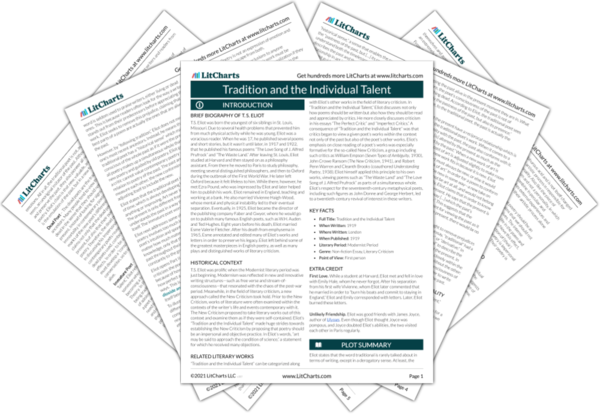Brief Biography of T. S. Eliot
T.S. Eliot was born the youngest of six siblings in St. Louis, Missouri. Due to several health problems that prevented him from much physical activity while he was young, Eliot was a voracious reader. When he was 17, he published several poems and short stories, but it wasn’t until later, in 1917 and 1922, that he published his famous poems “The Love Song of J. Alfred Prufrock” and “The Waste Land.” After leaving St. Louis, Eliot studied at Harvard and then stayed on as a philosophy assistant. From there he moved to Paris to study philosophy, meeting several distinguished philosophers, and then to Oxford during the outbreak of the First World War. He later left Oxford because it felt lifeless to him. While there, however, he met Ezra Pound, who was impressed by Eliot and later helped him to publish his work. Eliot remained in England, teaching and working at a bank. He also married Vivienne Haigh-Wood, whose mental and physical instability led to their eventual separation. Eventually, in 1925, Eliot became the director of the publishing company Faber and Gwyer, where he would go on to publish many famous English poets, such as W.H. Auden and Ted Hughes. Eight years before his death, Eliot married Esme Valerie Fletcher. After his death from emphysema in 1965, Esme annotated and edited many of Eliot’s works and letters in order to preserve his legacy. Eliot left behind some of the greatest masterpieces in English poetry, as well as many plays and distinguished works of literary criticism.
Historical Context of Tradition and the Individual Talent
T.S. Eliot was prolific when the Modernist literary period was just beginning. Modernism was reflected in new and innovative writing structures—such as free verse and stream-of-consciousness—that resonated with the chaos of the post-war period. Meanwhile, in the field of literary criticism, a new approach called the New Criticism took hold. Prior to the New Criticism, works of literature were often examined within the contexts of the writer’s life and events contemporary with it. The New Criticism proposed to take literary works out of this context and examine them as if they were self-contained. Eliot’s “Tradition and the Individual Talent” made huge strides towards establishing the New Criticism by proposing that poetry should be an impersonal and objective practice. In Eliot’s words, “art may be said to approach the condition of science,” a statement for which he received many objections.
Other Books Related to Tradition and the Individual Talent
“Tradition and the Individual Talent” can be categorized along with Eliot’s other works in the field of literary criticism. In “Tradition and the Individual Talent,” Eliot discusses not only how poems should be written but also how they should be read and appreciated by critics. He more closely discusses criticism in his essays “The Perfect Critic” and “Imperfect Critics.” A consequence of “Tradition and the Individual Talent” was that critics began to view a given poet’s works within the context not only of the past but also of the poet’s other works. Eliot’s emphasis on close reading of a poet’s works was especially formative for the so-called New Criticism, a group including such critics as William Empson (Seven Types of Ambiguity, 1930), John Crowe Ransom (The New Criticism, 1941), and Robert Penn Warren and Cleanth Brooks (coauthored Understanding Poetry, 1938). Eliot himself applied this principle to his own works, viewing poems such as “The Waste Land” and “The Love Song of J. Alfred Prufrock” as parts of a simultaneous whole. Eliot’s respect for the seventeenth-century metaphysical poets, including such figures as John Donne and George Herbert, led to a twentieth-century revival of interest in these writers.
Key Facts about Tradition and the Individual Talent
-
Full Title: Tradition and the Individual Talent
-
When Written: 1919
-
Where Written: London
-
When Published: 1919
-
Literary Period: Modernist Period
-
Genre: Non-fiction Essay, Literary Criticism
-
Point of View: First person
Extra Credit for Tradition and the Individual Talent
